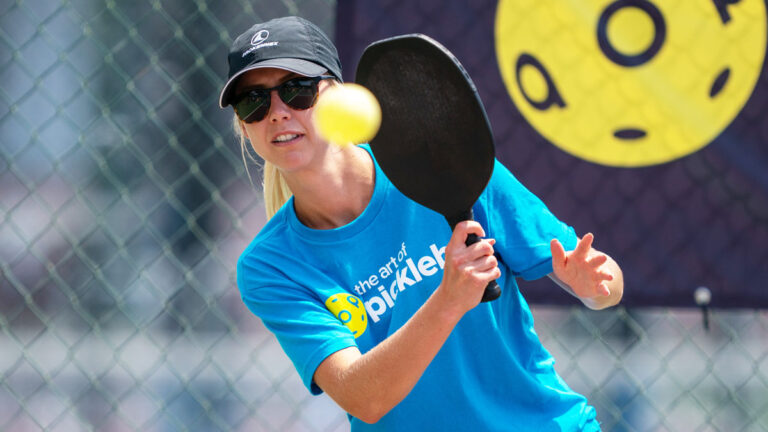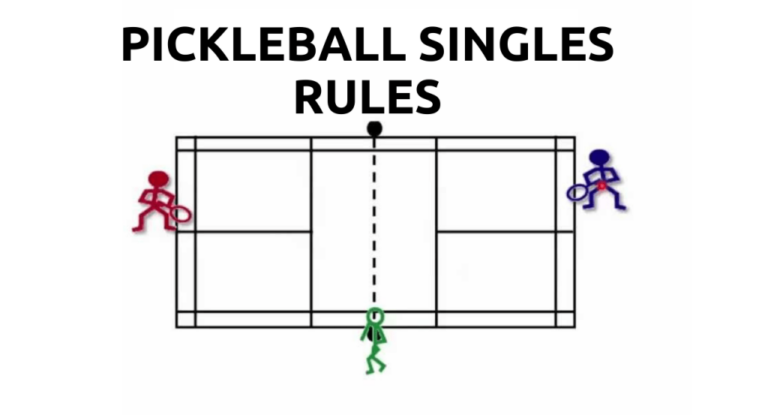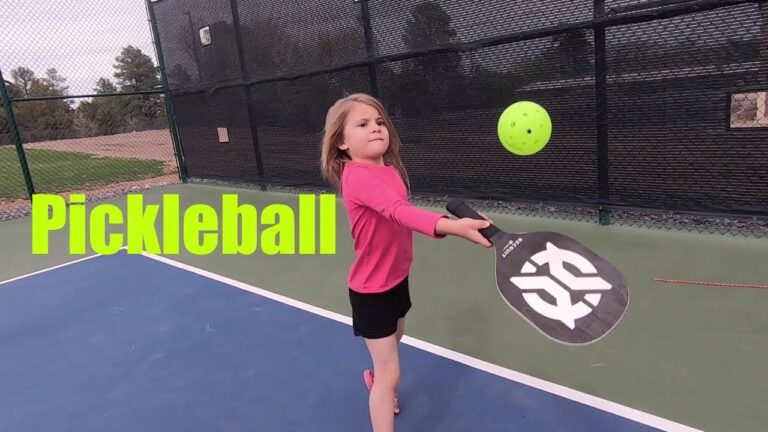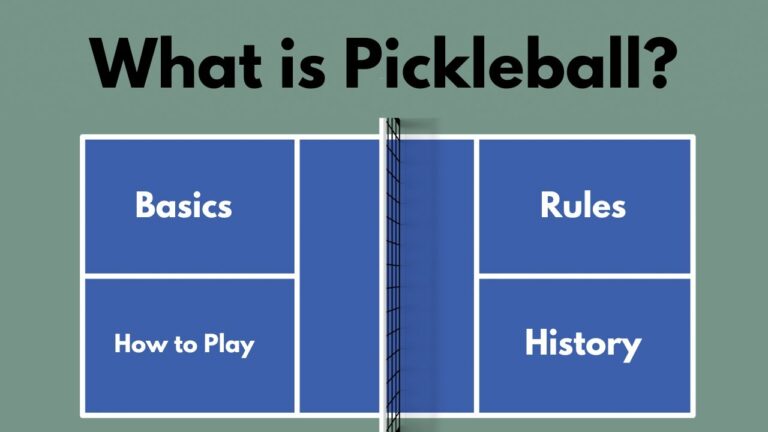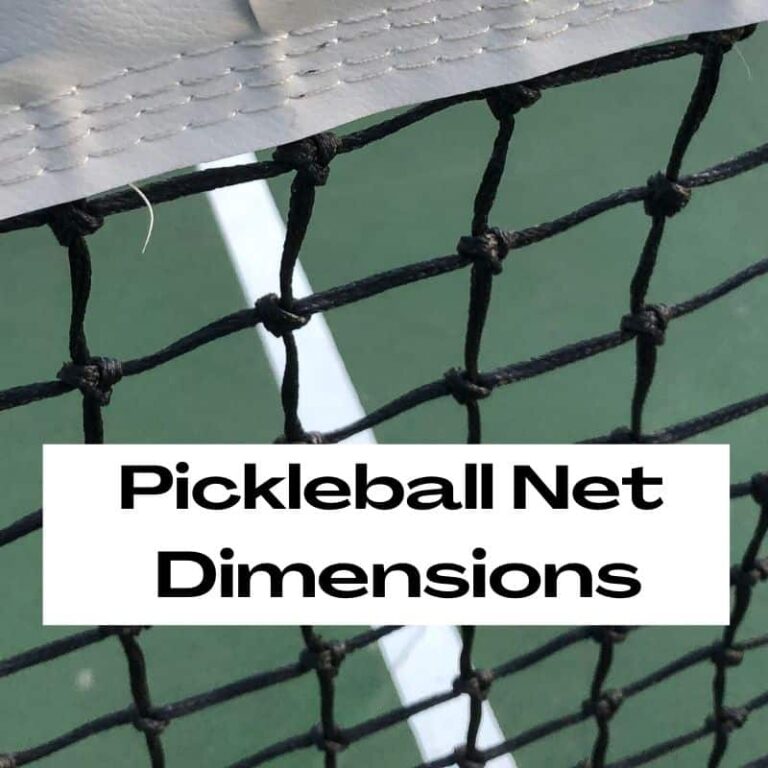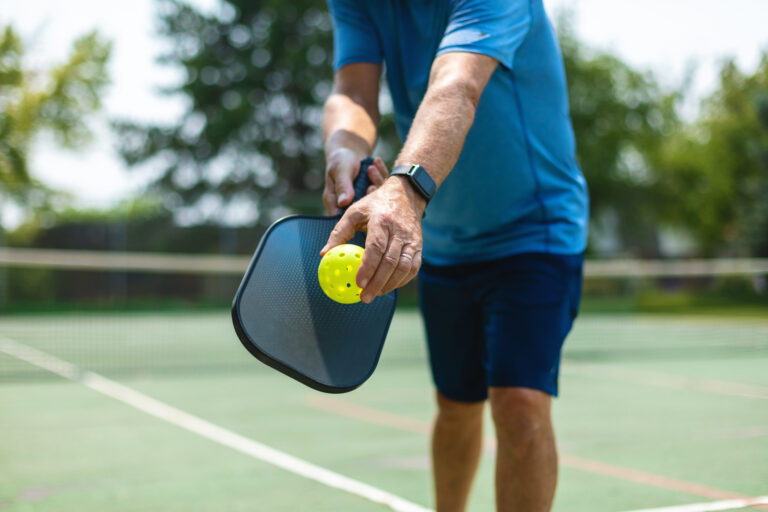Staying out of the Kitchen in Pickleball
Key Takeaways:
- The “kitchen” or non-volley zone is the 7-foot area on each side of the pickleball net where volleying is prohibited
- Faults are committed by volleying while in the kitchen or allowing momentum to carry you into the kitchen after a volley
- Players can legally enter the kitchen as long as the ball has bounced, but cannot volley from there
- Special techniques like the “windshield wiper” and strategic positioning help avoid kitchen violations
- Training drills and understanding advanced concepts like the momentum rule are crucial for competitive players
Staying Out of the Kitchen: The Golden Rule of Pickleball

As the fastest growing sport in America, pickleball has captured the hearts and sweat of millions with its easy learning curve and addictive gameplay. But amid all the dinking, slamming, and friendly trash-talking, one rule stands out as the great kitchen gatekeeper: stay out unless you’ve got a golden (bounced) ticket!
Understanding the Kitchen Crime Scene
Let’s start by defining the scene of the crime, shall we? The kitchen, also known as the non-volley zone or simply the “kitchen line,” is that 7-foot area extending from each side of the net. Think of it as:
- A neutral territory
- A demilitarized zone
- Where the net guardians dare not volley their vinegary zingers
But why such a sacred rule? Well, my picklepaddle pals, the kitchen keeps the game from devolving into a reenactment of the Battle of Winterfell, with players:
- Camped at the net
- Slashing away endlessly
- Turning it into a monotonous exchange
Instead, it ensures an engaging, strategic dance between teams rather than a rapid-fire shootout.
The Kitchen Code: Violation = Felony
Now, let’s get down to business and review the kitchen code, straight from the official rulebook:
- The Volley Violation: You cannot hit a volley while inside the kitchen lines or while any part of your body or paddle touches the kitchen area. That’s a big no-no, folks!
- The Momentum Misdemeanor: If your momentum from volleying a ball carries you (or any part of your body/equipment) into the kitchen, even if you started outside, that’s also a fault. The kitchen is a no-fly zone during volleys.
- The Punishment: Commit a kitchen violation, and you’ll find yourself singing “Swing Low, Sweet Chariot” as you hand over the serve to your opponents. Every fault means a loss of serve or side out.
But fear not, my dill-icious friends! There are a few exceptions to this pickle-y predicament:
✔️ You can legally stand inside the kitchen all day if the ball has bounced. The rules only apply to volleys.
✔️ A serve touching the non-volley line is considered a fault because it didn’t clear the zone, but you can stand in the kitchen to serve.
✔️ And for all you hot-shots, jumping up to hit a volley from outside the kitchen and landing inside is still kosher!
Strategies for Steering Clear of the Kitchen Calamity
Now that we’ve outlined the basic kitchen rules let’s explore some pro tips and techniques to keep you out of this pickle:
1) The Windshield Wiper Maneuver: Picture this: you’re at the kitchen line, the ball is screaming towards you at mach speed, and your instinct is to drop that hot potato with a crisp volley. But wait! Before committing this fatal error, use the “windshield wiper” technique.
Swing that paddle nice and low to the ground, allowing the ball to bounce first before making contact. It may feel unnatural at first, but with practice, you’ll be clearing those kitchen counters like a pro.
2) Strategic Positioning: One of the beauties of pickleball is the compact court size and fast-paced action. But this also means you need to be light on your feet to avoid those kitchen catastrophes. A good rule of thumb is to take a couple of steps back from the kitchen line during rallies to give yourself some buffer room.
For you serious competitors out there, check out this strategic positioning cheat sheet:
| Positioning Strategy | Offensive | Defensive |
|---|---|---|
| Singles | 3-4 ft from kitchen | 5-6 ft back |
| Doubles (up player) | 1-2 ft from kitchen | 3-4 ft back |
| Doubles (back player) | 5-6 ft from baseline | 7-8 ft back |
3) “Get Low” Training Drills: Some of the best players make staying out of the kitchen look effortless. But that level of finesse requires serious practice and muscle memory. Drills like the “sacrifice bunny” and “grinder” can sharpen your ability to hit those dinks and drives from low positions.
Just set up on the kitchen line and have a partner pepper you with shots, focusing on making contact below knee level. It may feel like death by a thousand paper cuts at first, but stick with it! Over time, your low-ball reflexes will have you dodging kitchen violations like Neo in the Matrix.
Other helpful drills include:
- The “peanut butter” – dinking back and forth cross-court from the kitchen line
- “Wallball” kitchen drills – hitting a ball off a wall from kitchen positions
- Lateral movement and shot separation exercises
[Internal Link 2: Pickleball Court Dimensions]
For the Pros: Advanced Kitchen Concepts
Think you’ve mastered the kitchen basics? Well, strap in, because we’re about to venture into some deep-fried, beer-battered advanced territory. Bon appétit!
The Momentum Ruling Explained
We touched on this earlier, but the “momentum rule” is a crucial concept that separates the picklers from the true pickleball prodigies. As the official rulebook states, “A fault will be declared if, after volleying a ball, a player’s momentum causes them or anything they are wearing or carrying to touch the non-volley zone.”
In plain English, this means if your follow-through motion from a volley has you:
- Lunging
- Jumping
- Falling
…into the no-volley zone, you done goofed, my friend! Some common momentum violations include:
- Lunging to reach a deep volley, and your foot touches the kitchen
- Jumping up to smash a volley, and you land in the death zone
- Swinging with so much gusto that your hat/visor/hairpiece ends up doing the salsa in the kitchen
The key is being in complete control of your body movement after contact. No full-extensions, no wild windmills – just nice, clean, contained strokes.
Mythbusting the Kitchen Code
Like any sport, pickleball has its fair share of urban legends and broscience surrounding the kitchen rules. It’s time to separate fact from fiction:
Myth: You can quickly shuffle your feet across the kitchen line mid-volley, as long as you don’t fully plant them.
Reality: Nope! Any part of your body or equipment touching the non-volley zone after volleying is a fault. Your footwork game better be en pointe.
Myth: Following through on a volley so your paddle momentarily crosses the kitchen line is okay.
Reality: What did the paddle ever do to you? Guilty by association – any part of your body OR equipment making kitchen contact after a volley is illegal.
Myth: You can quickly jump from the kitchen to hit a volley, as long as you land outside the zone.
Reality: While jumping up to volley is fine, jumping FROM the kitchen is a violation, even if you land safely. The kitchen is strictly quarantined for volleys.
Other common misconceptions:
- You can quickly “tap” volley in the kitchen if your feet don’t plant
- Only your feet/legs count for kitchen violations, not paddles/arms
- You can volley “through” the kitchen if you start and end outside
Don’t get caught acting on bad pickleball mythology – know the rules!
[Internal Link 3: Pickleball Scoring Rules and Terminology]
Here’s a continuation of the expanded article with more tables, lists, and formatting to break up text:
Kitchen Mastery for Competitive Play

At an elite level, kitchen positioning and shot selection become intertwined game-plans. In doubles, communication and coordinated movement between partners is key, with one player manning the kitchen while the other provides support from the back. Well-drilled teams will:
✔️ Exploit gaps by controlling the middle
✔️ Aggressively attack and defend at the line
✔️ Use deception and varied spins/speeds to disrupt opponents
To properly train for these high-stakes scenarios:
✔️ Practice dinking scenarios from the kitchen line, mastering the art of placing the ball in precise corners.
✔️ Integrate ball-tracking and reactionary footwork drills so you can quickly get into position during fast exchanges.
✔️ Study pro matches and note how the top teams establish positions and force their opponents out of the kitchen through strategic shot selection.
Here are some example drills used by touring professionals:
| Drill Name | Description |
|---|---|
| Cross-Court Dinking | Dink back-and-forth cross-court from the kitchen line |
| Target Dinking | Call different targets and dink to those areas of the court |
| Rapid Reaction | Quick movements and returns from the non-volley zone |
| Neutral Rally Transitions | Transition to offensive/defensive kitchen positions |
The Mental Game: Kitchen Composure
While the physical aspects of kitchen control are crucial, the mental game is just as important at higher levels of pickleball. The non-volley zone is where the most intense actions happens – quick hands, rapid decisions, and easy faults.
Top players have trained themselves to:
- Maintain laser focus during fast exchanges
- Stay composed and patient when opponents are controlling the line
- Recognize opportune times to reset to neutral positions
- Remain confident in their dinking and anticipation abilities
Sports psychologists recommend techniques like positive self-talk, deep breathing, and mental rehearsal to stay zen in the kitchen’s pressure-cooker.
The Proof is in the Pickleball Pudding
At the end of the day, while the kitchen rule may seem restrictive at first, it’s a core reason why pickleball is so beginner-friendly AND entertaining to play at advanced levels. By governing that 7-foot no-man’s land, the rules inject an extra layer of:
- Strategy
- Movement
- Flat-out athleticism
…into every point.
Just look at the best players in the world – they seem to glide around the court with unnatural grace, threading the needle between attack and defense. But watch closely and you’ll see the subtle adjustments in:
- Footwork
- Racket preparation
- Body positioning
…that allow them to harness the kitchen’s powers while respecting its boundaries.
So whether you’re a newly-minted pickleballer or a salty court veteran, mastering the non-volley zone is a journey worth taking. Not only will it elevate your understanding of the game’s nuances, but it will also transform you into a more versatile, tactically-sound competitor.
Who knows, you may even unlock some hidden super-dinking abilities in the process! Some say those who fully embody the kitchen code develop a mystical “sixth sense” for placing dinks with utmost precision. But I won’t go spreading rumors…
[Internal Link 4: How to Choose the Right Pickleball Paddle]
Frequently Queried Kitchen Quandaries
Before I let you spreechickens back into the wild, let’s address a few frequently asked questions about this hallowed pickleball ground:
Can I ever volley in the kitchen?
Only if you’re intentionally trying to commit court heresy and sacrifice the point! Unless…do you know something about bending the laws of physics that the rest of us don’t?
What if my paddle or clothing brushes the kitchen during a volley?
Sorry, your paddle doesn’t get some special “inanimate object” exemption. If any part of your body, held objects, OR worn items make contact with the non-volley zone, you’re going to be flagged for a violation faster than you can say “objection!”
How does the serve relate to the kitchen rules?
Technically, the server is never allowed to step into the non-volley zone because every serve is considered a volley until it bounces. So your toes best be clear of that kitchen line when you tee off! On the plus side, non-serving players can hang out in the kitchen during serves.
Can I momentarily jump/lunge through the kitchen?
Nope, any entrance into the kitchen during a volley, even for a split-second, is illegal. The only way to stay out of trouble is to completely avoid any overlap between your body/equipment and that sacred non-volley zone.
Other common kitchen rule FAQs:
- What if the ball rolls into the kitchen? (Legal, as long as you don’t volley it)
- Can I fake like I’m going to volley to draw my opponent out? (Yes, but no actual volleys!)
- How many faults before I’m ejected from the kitchen party? (Every fault results in a fault/side out)
The Last Serving
Well, folks, I’d say we’ve thoroughly dissected, marinated, and fried up this whole “staying out of the kitchen” concept. The non-volley zone may seem like a strict headmistress at first, but follow her rules, and you’ll be rewarded with more enjoyable, strategic, and athletic matches.
The key is focusing your practice time on:
- Developing lower body dinking mechanics
- Improving court awareness and positioning
- Understanding advanced rules like the momentum violation
So watch those footsies, keep those volleys in check, and pickle on, my friends! The healthiest addiction around awaits you out there on the courts. Respect the kitchen’s boundaries, and you’ll be a panera-amic success!

